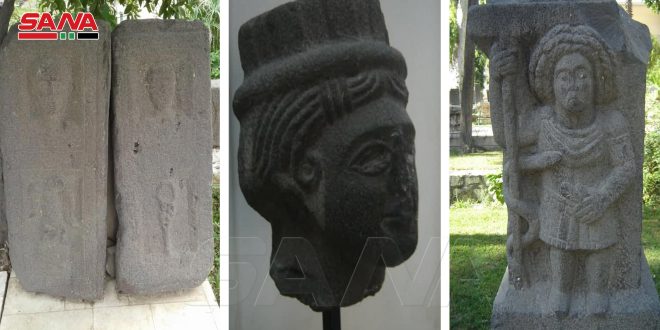Symbolizing commerce, medicine and pharmacy … Three sculptures decorate the National Museum in Damascus
Al Sweida, (ST) – The basalt carvings decorating the garden of the National Museum of Damascus is one of the ancient Syrian civilization’s components that represent living evidence that our country is the cradle of civilization. Each of these sculptures symbolize a profession of trade, medicine, and pharmacy, and each has its own interpretation and myth.
In a statement to SANA, head of the Damascus University branch in Sweida, researcher Dr. Khaled Kiwan said that one of these carvings is basically two shutters for the door of “Hillis.” At the bottom of the right shutter there is an image representing the god “Hermes” or the so-called god of commerce, who is also the lord of merchants and money and protector of roads and caravans. He pointed out that “Hermes” is one of the names of the planet Mercury, a mythical Greek figure, as well as the name of one of Greece’s prominent gods.
The second sculpture, according to Kiwan, represents “Esculab”, the Greek god of medicine, indicating that “Esculab” is an ancient Arab god and its well-known symbol is the snake. It was known as “Aximon” by the Syrians, while it was according to the Sumerians, the god of wisdom and medicine in Mesopotamia. The worship of this god was held next to the springs while in his temple they used to worship the snake, which is the symbol of life.
Kiwan went on to say that the third sculpture represents the goddess “Higa”, daughter of the god “Asclepus”, the goddess of purity. It symbolizes the pharmacy profession whose sign is the cup and the serpent, as her father, Asclepus, healed diseases while her role was to prevent diseases. She was depicted in ancient statues as she was holding a cup with a snake secreting poison in it to be used as medicine, pointing out that these professions were associated with the gods as they were sacred professions based on honor, sincerity, and honesty.
The National Museum of Damascus includes several monuments from Jabal al-Arab, such as the painting of justice, philosophy, and education, and the sculpture of the god “Mithir” the god of light. “Hercules” and his struggle with the Nemean lion , the statue of the goddess Athena “Minerva”, the statues of “Victoria”, the statue of the god Bacchus and the head of the god “Baal Shamin, are also among the most prominent monuments of the museum.”
Amal Farhat

